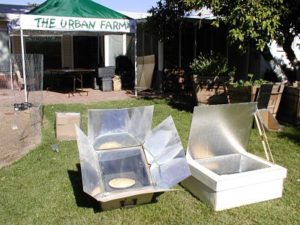 The Urban Farming Tip for September 2017 is close to my heart. Y’all who know me, know that I’m a fan of solar energy.
The Urban Farming Tip for September 2017 is close to my heart. Y’all who know me, know that I’m a fan of solar energy.
Well, before there were solar panels and the utility company battles to stop their distribution, there was solar cooking.
For years, folks looked with on with smirks as solar enthusiasts cooked food in their back yards in the sun. Well, that was the beginning of a movement which looks much different now, but which comes from the same ethos –independence, sustainability and creativity.
So, for this Urban Farming Tip, we check in again with our favorite urban farmer Greg Peterson, as they give you the details on how to use a solar cooker. Below is an excerpt.
“Sunlight—we all get some or a lot, but besides turning it into a nice tan, heating water or making a few hundred watts of electricity, what else can you do with the brilliant sunshine? How about channeling it into a cost-effective, energy-saving tool for cooking? Yep, I am talking about one of the greenest practices custom-made for us: the solar oven.
Believe it or not, solar cookers can be as fancy or as simple as regular kitchen ovens. Well, OK, most kitchen ovens are not quite as simple as an insulated cardboard box pointed at the sun, but there is quite a gamut of solar ovens available. In fact, my first solar oven was made by the Kerr-Cole Sustainable Living Center in Taylor, Arizona. Talk about basic: it was a cardboard box inside another cardboard box with insulation in between. But boy, did it work. Its internal temperatures regularly exceed 325° F. A little fancier and made from sturdier materials, my new solar oven is a Sun Oven, and can easily get up to 375° F.
Even better, solar ovens are a little like a two-for-one deal. They can serve as either a crockpot, where the temperature rises slowly, slow-cooking food throughout the day, or as a regular oven, baking, steaming or boiling all types of food. Plus the even temperatures of a solar oven help prevent overcooking. In fact, using my solar oven almost feels like cheating – no electricity, so no fear of burning my dinner and it couldn’t be more natural.
I know we’ve had some interesting weather, but don’t be fooled. Even though the sidewalks aren’t hot and it is brisk outside, the sun is bright enough to cook food. In fact, “a 40-degree, low-humidity day will allow food to cook faster than a 100-degree day with high humidity,” according to the makers of the Global Sun Oven. But remember that the days are getting shorter, so cooking hours will be somewhat limited.
If you’re considering a solar oven, here are some points to consider:
- Sunlight is free. This goes without saying, but it’s important to consider as the economy continues to shift. The initial investment can vary from under $100 up to $300 or $400, depending on type and model, but there’s absolutely no cost beyond that.
- Pots and pans. Feel free to use your regular kitchen pots and pans in these ovens, just keep in mind that shinier materials like aluminum will reflect light rather than absorb it, so darker, thin-walled pots are best.
- TLC. Using a solar oven can require a little more tender loving care. If you intend to use your solar oven like a conventional oven, it is recommended that you reposition your oven to point at the sun every 25 to 30 minutes to ensure a thorough cooking. This might be problematic, but remember, there’s no stirring or other attention needed.
- Lazy cooking. For those of you who are lazy like me, you can also use your solar oven like a crockpot. Load it up in the morning and point it south, then go to work and let the oven slow-cook your dinner.
- Taste. They say it has to do with the lack of air circulating through the solar oven, but whatever the scientific reason, I have found food cooked in a solar oven to taste simply incredible. Even breads taste better baked in a solar oven.
There are many types and models of solar cookers available, so check around and ask questions as you consider this investment. I have enjoyed both my models – especially since they have been such a pain-free way to help the environment.
And to be honest, since it’s hard to burn anything in a solar oven, it has dramatically improved my cooking skills, too.”
We made a solar dehydrator at our house recently, and we’ve hd some good luck using that. We used it to dehydrate food that we took on a hiking trip with us. Amazing thing: it tastes so much better than dehydrated food from the store. So, maybe our next Urban Farming Tip will cover that process.









